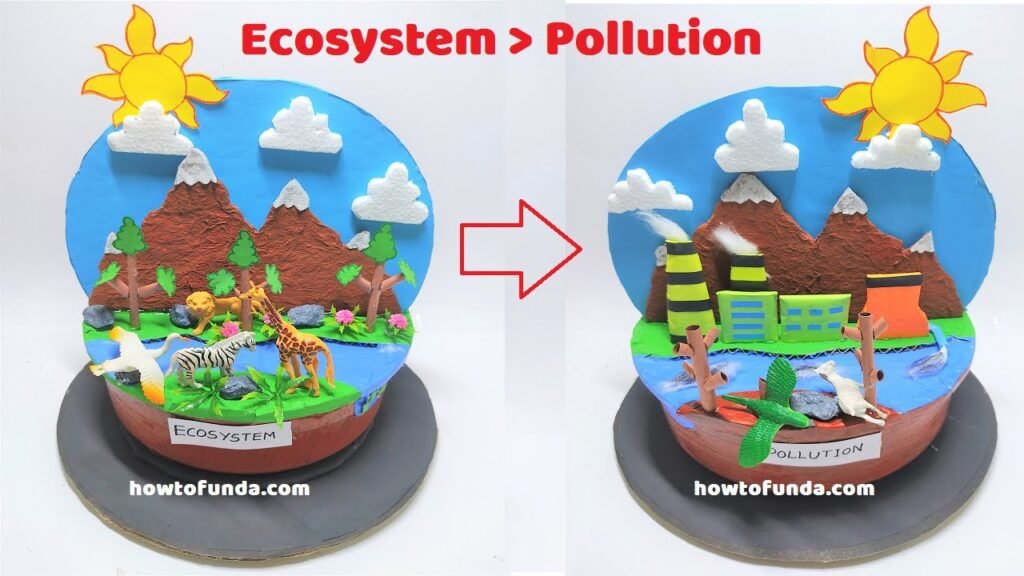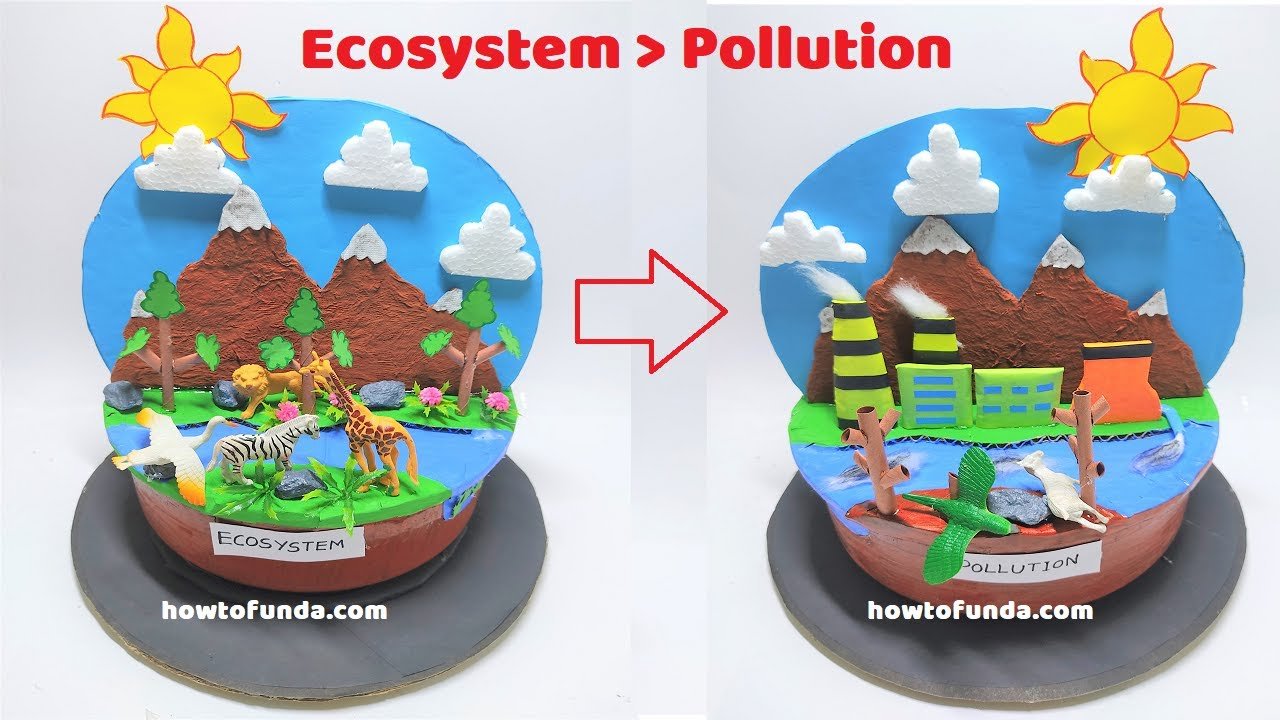Creating a detailed and visually appealing ecosystem and pollution model for a science project is an excellent way to illustrate the balance of nature and the impact of pollution.
Here’s a step-by-step guide to help you build this model using various materials like cardboard, color paper, and simple craft supplies:


Materials Needed:
- Large cardboard base
- Cardboard or foam board (for mountains and other structures)
- Color paper (green, blue, brown, etc.)
- Paints and brushes (optional, for additional decoration)
- Scissors and craft knife
- Glue or tape
- Small plastic or paper animals (or animal cutouts)
- Cotton balls (for clouds)
- Clear plastic wrap or blue cellophane (for water bodies)
- Small twigs or green felt (for trees and forest)
- Markers or pens
- Recycled materials (bottle caps, small boxes, etc., to represent pollution)
- String or thin yarn (for rivers and streams)
- Small pebbles or sand (for realistic texture)
Step by Step Video Instructions:
1. Prepare the Base:
- Take a large piece of cardboard to use as the base for your model.
- Paint or cover the base with green color paper to represent the ground.
2. Create the Mountains:
- Cut pieces of cardboard or foam board into triangular shapes to form mountains.
- Assemble the pieces and glue them together to form 3D mountains.
- Cover the mountains with brown color paper or paint them brown. You can add white paper or paint at the peaks to represent snow.
3. Add Water Bodies:
- Use blue cellophane or clear plastic wrap to create lakes and rivers. Cut them to the desired shapes and glue them to the base.
- Use string or thin yarn to represent smaller streams flowing from the mountains.
4. Construct the Forest:
- Gather small twigs or use green felt to create trees. You can also make trees from green color paper by cutting out tree shapes and attaching them to small sticks.
- Arrange the trees in a section of the model to represent a forest.
5. Place the Animals:
- Place small plastic or paper animals throughout the ecosystem. Position them in appropriate habitats (e.g., deer in the forest, fish in the water).
6. Add Clouds:
- Stretch and shape cotton balls to create clouds. Attach them to the top of the mountains and other parts of the sky area using glue.
7. Introduce Pollution Elements:
- Use recycled materials like bottle caps, small boxes, and plastic pieces to represent pollution. Place these items in different areas to show the impact of pollution on the ecosystem.
- You can also add oil spills (using black paint or marker) in the water bodies and litter on the ground.
8. Label the Parts:
- Cut small pieces of color paper to create labels for each part of the ecosystem: Mountains, Forest, River, Lake, Animals, Pollution, etc.
- Write the names on the labels and attach them to the corresponding parts of the model using glue or tape.
Explanation:
This model represents a balanced ecosystem, showcasing the interconnectedness of mountains, forests, rivers, lakes, and wildlife, as well as the impact of pollution.
Here’s how our model works:
- Mountains: The mountains are the source of rivers and streams. Snow at the peaks melts and flows down as water, providing essential resources for plants and animals.
- Forest: The forest is home to various animals and plants. Trees play a crucial role in producing oxygen, maintaining air quality, and providing habitat for wildlife.
- Water Bodies: Rivers, lakes, and streams are vital for sustaining life. They provide drinking water for animals, support aquatic life, and nourish plants.
- Animals: Different animals inhabit various parts of the ecosystem. They interact with each other and their environment, forming a complex web of life.
- Pollution: The introduction of pollutants like plastic waste, oil spills, and litter disrupts the natural balance. Pollution affects the health of water bodies, plants, and animals, leading to negative consequences for the entire ecosystem.
This model highlights the importance of maintaining a clean and healthy environment. Pollution can have devastating effects on ecosystems, but by understanding its impact, we can take steps to protect and preserve our natural world.

